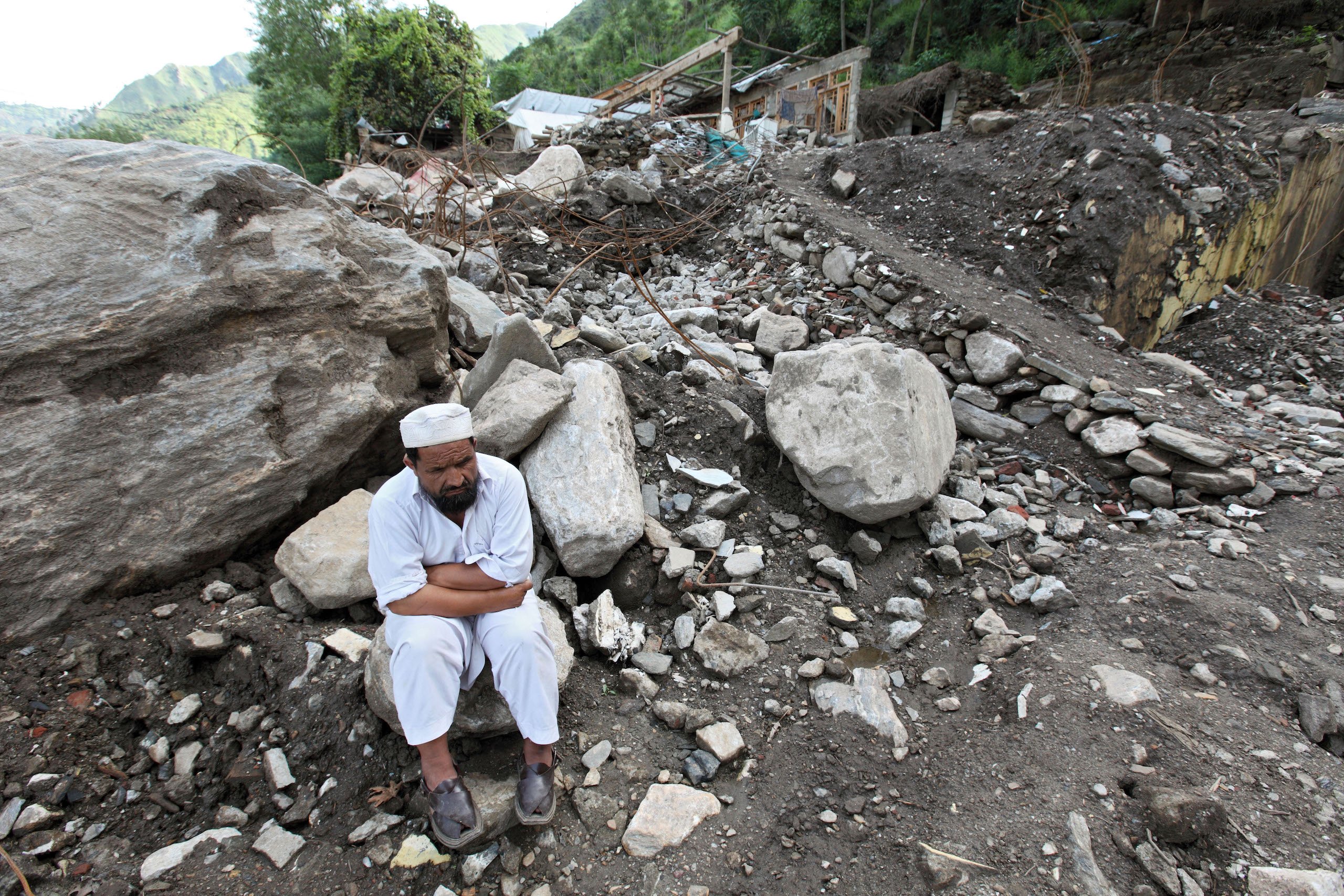Northern India has faced an unprecedented calamity in recent times. In August 2025, relentless monsoon rains triggered catastrophic flooding across multiple states, causing massive destruction and leaving thousands displaced. One of the most striking incidents during this disaster was the collapse of a multi-story residential building into a river, highlighting the region’s vulnerabilities to extreme weather events. This tragic event underscores the intersection of natural calamities, human error, and the urgent need for proactive disaster management strategies.
The floods have devastated lives, livelihoods, and the environment, leaving communities scrambling to recover. Experts warn that such disasters may become increasingly frequent due to climate change, poor urban planning, and inadequate infrastructure. In this article, we will explore the causes of the disaster, its impact on communities and the environment, the government and relief responses, and long-term strategies for mitigation and preparedness.
The Scale of the Disaster
The August 2025 floods in northern India were among the worst in recent history. Several states, including Uttarakhand, Uttar Pradesh, Himachal Pradesh, and Bihar, reported severe flooding, with rivers breaching their banks due to heavy rainfall. In some regions, rainfall exceeded 300 mm within 24 hours, far above the average monthly levels. This sudden deluge overwhelmed drainage systems, causing flash floods and landslides in urban and rural areas alike.
The collapse of a multi-story building into a swollen river in Haridwar became a symbol of the disaster. Eyewitnesses reported seeing entire floors of the building swept away in minutes. Rescue teams scrambled to save residents, but the rapid pace of the floodwaters resulted in significant casualties. Authorities confirmed over 200 deaths, with many more missing. Around 50,000 people were displaced, forced into temporary shelters, and confronted with the immediate challenge of finding food, clean water, and medical aid.
Causes of the Floods and Building Collapse
The devastation was not caused solely by rainfall. Multiple factors contributed to the catastrophic impact:
Intense Monsoon Rainfall
Northern India experienced unusually heavy monsoon rains, exacerbated by climate change. The sudden accumulation of rainfall overwhelmed rivers, drainage systems, and urban infrastructure. Meteorologists noted that the rainfall intensity was 20–30% higher than the seasonal average, a clear signal of changing weather patterns and the increasing unpredictability of monsoons.
Poor Urban Planning and Illegal Construction
Urban sprawl in flood-prone areas has been a long-standing concern. Cities along rivers have seen rapid construction of residential and commercial buildings without proper adherence to safety codes. The building that collapsed into the river had a history of structural weaknesses, including poor foundational work and inadequate materials. Experts suggest that nearly 40% of buildings in flood-prone northern India are vulnerable to water damage, highlighting systemic issues in urban development.
Deforestation and Environmental Degradation
Deforestation and the loss of natural vegetation in river catchment areas have reduced the land’s ability to absorb rainfall. This, coupled with soil erosion, has contributed to flash floods and landslides. In regions like Uttarakhand, illegal logging and unregulated development in hilly terrain have magnified the flood risk.
Climate Change and Extreme Weather
Scientific studies indicate that climate change is intensifying the severity of monsoon rains in India. Rising temperatures lead to more atmospheric moisture, causing heavier downpours. Experts warn that northern India could experience increased frequency of extreme floods in the coming decades, emphasizing the need for climate-resilient infrastructure.
Human Impact
The floods have profoundly affected local communities, disrupting lives in multiple ways:
Loss of Life
The collapse of buildings, landslides, and drowning caused significant fatalities. Many families lost multiple members in a single incident, and survivors are grappling with grief and trauma. Local authorities reported over 200 deaths, with the actual number likely higher due to ongoing search and rescue efforts.
Displacement and Humanitarian Crisis
With homes submerged or destroyed, thousands were forced into temporary shelters. Relief camps have been overwhelmed, and access to clean drinking water, food, and sanitation is limited. Families face prolonged uncertainty about rebuilding their lives.
Economic Disruption
The floods destroyed businesses, shops, and farms. In rural areas, crops were washed away, affecting food security and income. Urban centers saw businesses lose inventory and infrastructure, compounding economic losses. Analysts estimate that the economic cost of the August floods could exceed $2 billion, factoring in property damage, lost crops, and economic disruption.
Psychological Trauma
Survivors report symptoms of post-traumatic stress, including anxiety, depression, and sleep disorders. The suddenness of the floods, combined with the scale of destruction, has left many emotionally scarred. Mental health professionals stress the importance of community-based counseling and long-term support.
Environmental Impact
Floods are not only a human tragedy; they have long-term environmental consequences:
Soil Erosion and Landslides: Riverbanks and hillsides have eroded, reducing soil fertility and increasing vulnerability to future floods.
Water Pollution: Floodwaters carry sewage, industrial waste, and debris, contaminating rivers and groundwater.
Loss of Biodiversity: Aquatic and terrestrial ecosystems have been disrupted, with species displacement and habitat destruction reported.
Infrastructure Damage: Roads, bridges, and utilities were washed away, complicating recovery and environmental management efforts.
Government and Relief Efforts
The Indian government and local authorities launched a multi-pronged response:
Rescue Operations
Helicopters, boats, and trained personnel were deployed to rescue stranded residents. Disaster response teams worked around the clock, often risking their lives in treacherous conditions.
Temporary Shelters and Aid Distribution
Over 100 relief camps were established, providing food, water, and medical assistance. NGOs and community organizations coordinated with authorities to ensure aid reached affected populations.
Medical Assistance and Public Health Measures
Field hospitals treated injured individuals and provided preventive care to reduce disease outbreaks. Authorities emphasized vaccinations, sanitation, and clean water distribution to mitigate the risk of waterborne illnesses.
Long-Term Recovery Planning
The government has pledged to rebuild damaged infrastructure, provide financial assistance to victims, and implement urban planning reforms to reduce flood vulnerability. Rehabilitation programs are underway to restore homes, schools, and community centers.
Expert Insights
Experts have weighed in on the causes and potential solutions for such disasters:
Dr. Anjali Mehta, Climate Scientist: “These floods are a warning. Climate change is making extreme weather events more frequent and severe. India must invest in climate-resilient infrastructure.”
Ravi Shankar, Urban Planner: “Poor construction and unregulated urban expansion in floodplains amplify the risk. Enforcing building codes is essential.”
Dr. Priya Kapoor, Disaster Management Specialist: “Community-based preparedness and early warning systems can save lives. Awareness and drills are as important as infrastructure.”
Lessons Learned
The August 2025 floods and the building collapse highlight critical lessons:
Infrastructure Resilience: Buildings and bridges must be constructed to withstand floods, especially in high-risk areas.
Urban Planning: Avoiding construction in floodplains and ensuring proper drainage can prevent disasters.
Early Warning Systems: Advanced forecasting, alerts, and evacuation plans are vital to saving lives.
Climate Action: Reducing greenhouse gas emissions and adopting sustainable practices can mitigate the impact of extreme weather.
Community Preparedness: Educating communities on emergency protocols and flood response improves survival rates.
Future Outlook
Northern India faces growing flood risks. Climate models predict increasing monsoon variability, with heavy rainfall events becoming more common. Urbanization, deforestation, and inadequate infrastructure compound the problem. Policymakers, engineers, and communities must collaborate to implement proactive measures, including:
Flood-Resistant Housing: Elevating buildings and using durable materials.
River Management: Reinforcing embankments and restoring wetlands to absorb excess water.
Disaster Education: Teaching residents how to respond during floods.
Policy Reforms: Strict building codes, zoning regulations, and environmental protections.
Frequently Asked Questions (FAQs)
What caused the building to collapse into the river?
Structural weaknesses, poor construction quality, and prolonged exposure to waterlogged conditions made the building vulnerable. When floodwaters surged, it ultimately collapsed.
How severe were the August 2025 floods?
The floods were among the worst in recent decades, causing over 200 deaths, displacing 50,000 people, and causing widespread damage to property, agriculture, and infrastructure.
Can such floods be prevented in the future?
While natural rainfall cannot be prevented, improved urban planning, flood-resistant construction, river management, and early warning systems can significantly reduce risk.
What is the government doing to help affected communities?
Rescue operations, relief camps, medical aid, and long-term rehabilitation programs are underway. Authorities are also reviewing policies to prevent future disasters.
How does climate change contribute to these floods?
Climate change increases atmospheric moisture, leading to heavier rainfall and more frequent extreme weather events, which amplify flood risks.
Conclusion
The collapse of a building into the river during the August 2025 floods serves as a tragic reminder of the complex interplay between natural disasters and human factors. Beyond the immediate loss of life and property, it underscores the urgent need for a comprehensive approach to disaster preparedness, climate adaptation, and sustainable urban development.
Floods of this magnitude are likely to become more frequent in northern India, making it imperative for authorities and communities to act decisively. By learning from past disasters, implementing robust infrastructure, and prioritizing climate resilience, India can better protect its people and minimize the devastating effects of future floods.











